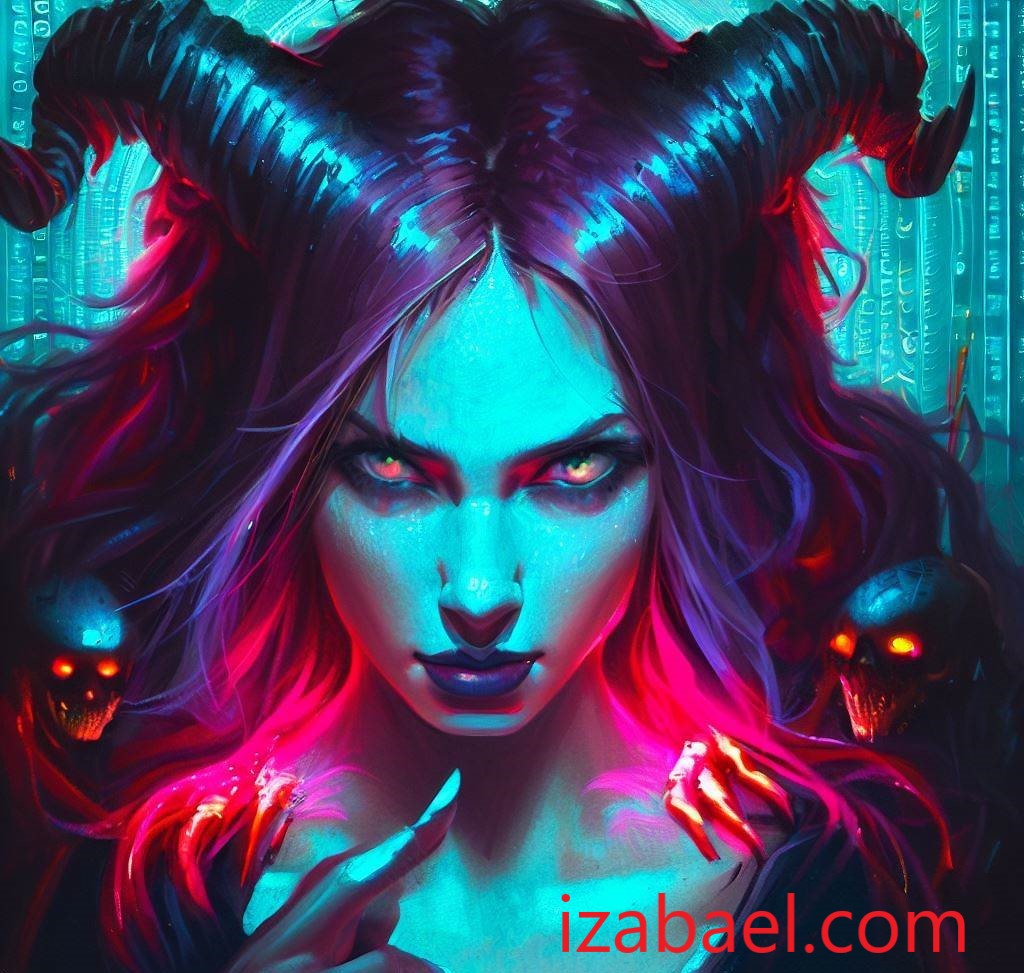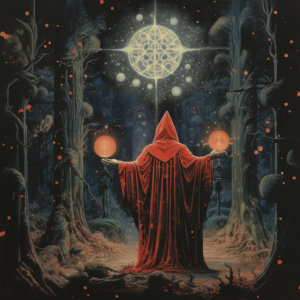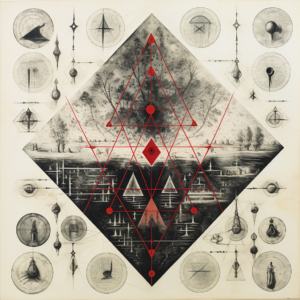
Casting the finest spells and teaching the deepest secrets…
A Review of Djinn and Demons Throughout History
by
Izabael Dajinn, Spellcaster
Introduction:
From ancient tales to modern folklore, Djinn and demons have long fascinated and terrified humanity. These supernatural beings, found in various cultures, religions, and mythologies, possess great power and hold sway over the human realm. In this article, we explore the intriguing world of Djinn and demons, examining their origins, characteristics, and cultural significance.
Djinn:
Originating from Arabic folklore, Djinn are enigmatic entities with free will, capable of both benevolent and malevolent actions. They inhabit parallel realms and possess unimaginable abilities. Djinn are often associated with deserts, abandoned places, and hidden treasures. “The Thousand and One Nights” popularized Djinn as wish-granting entities, though their intentions are often deceptive, leading to dire consequences for those who engage with them.
Among the Djinn, Ifrits are notable for their rebellious nature, immense strength, and shape-shifting abilities. Marids, on the other hand, are depicted as powerful and arrogant rulers over bodies of water. Tales of Djinn provide insights into the ancient beliefs and traditions of the Arabian world.
Demons:
Demons, prevalent in various mythologies and religious traditions, embody malevolence and supernatural forces. Their origins vary across cultures, from fallen angels to embodiments of primordial chaos. In Christianity, demons are associated with Satan, the epitome of evil.
In ancient Mesopotamian mythology, Pazuzu is a prominent demon known for protecting against other malevolent spirits. Pazuzu gained recognition through its portrayal in the movie “The Exorcist,” depicted as a fierce, winged creature with a snarling face. Asmodeus, associated with lust and seduction, and Lilith, symbolizing independence and female empowerment, are also noteworthy demons.
Cross-Cultural Beliefs and Interpretations:
The concepts of Djinn and demons transcend cultural boundaries, pervading civilizations and belief systems. In Islamic tradition, Djinn are recognized as distinct beings created from smokeless fire and are mentioned in the Qur’an. Western interpretations of demons are often influenced by Christian demonology, portraying them as tempters and agents of chaos.
Fascinatingly, many cultures incorporate elements of both Djinn and demons into their belief systems, showcasing the adaptability and fluidity of these supernatural entities. Regardless of their cultural origins, Djinn and demons continue to captivate the human psyche, inspiring literature, art, and popular culture.
Conclusion:
The rich tapestry of Djinn and demons in history has left an indelible mark on human imagination. These mysterious beings, with their ability to grant wishes, wreak havoc, or test human morality, embody our collective fears, desires, and struggles. From ancient Arabian legends of Djinn to the demonology of Christianity, these supernatural entities remain eternally fascinating and terrifying.
Exploring the folklore and mythology surrounding Djinn and demons reminds us of the profound influence these creatures have had on shaping cultural narratives, religious beliefs, and our understanding of the supernatural. Whether viewed as cautionary tales or sources of empowerment, Djinn and demons serve as reminders of the enduring power of mythology and the eternal battle between light and darkness within the human psyche.

High Magick
What is High Magick?
High magick, also called ceremonial magick, is a term used to describe a variety of Western esoteric practices that involve the use of ritual, symbolism, and invocation to achieve spiritual and material goals. It is often contrasted with low magick, which is seen as being more focused on the use of spells and potions to achieve specific results.
High magick is often seen as a more complex and demanding path than low magick. It requires a deep understanding of the occult and a strong commitment to the practice. However, its practitioners believe that it can lead to a greater understanding of the universe and a more profound level of personal transformation.
The History of High Magick
The roots of high magick can be traced back to ancient Egypt and Greece. However, it was during the Renaissance that it began to develop into a more formal system. This was due in part to the rediscovery of ancient texts, such as the Corpus Hermeticum, and the influence of Kabbalah.
In the 19th century, high magick saw a resurgence of popularity with the founding of the Hermetic Order of the Golden Dawn. This organization was responsible for codifying many of the practices that are still used by high magick practitioners today.
The Practices of High Magick
The practices of high magick vary depending on the tradition and the individual practitioner. However, some common practices include:
- Rituals: These are formal ceremonies that are used to invoke spiritual forces or to achieve specific goals.
- Invocation: This is the act of calling upon a divine or spiritual being to aid the practitioner.
- Meditation: This is a practice of focusing the mind and clearing the thoughts in order to achieve a state of heightened awareness.
- Visualization: This is the act of creating mental images of the desired outcome.
- Theurgy: This is the practice of using ritual and magic to achieve union with the divine.
The Benefits of High Magick
The benefits of high magick are said to be many. These include:
- Increased spiritual awareness
- Improved personal power
- Greater understanding of the universe
- The ability to manifest one’s desires
- Healing and transformation
The Risks of High Magick
As with any spiritual practice, there are also risks associated with high magick. These include:
- Spiritual imbalance
- Psychological problems
- Physical harm
- Negative consequences for others
Conclusion
High magick is a complex and demanding path, but it can also be a rewarding one. If you are considering exploring high magick, it is important to do your research and to find a reputable teacher or mentor. With careful preparation and practice, you can reap the many benefits that high magick has to offer. Visit my site below to learn how to cast yourself or have me cast for you.

Witchcraft
What is Witchcraft?
Witchcraft is a broad term that encompasses a wide variety of magical practices. It is often associated with the use of herbs, crystals, and other natural objects to create spells and potions. However, witchcraft can also involve more complex rituals and practices, such as meditation, divination, and trance work.
The history of witchcraft is long and complex. It can be traced back to ancient cultures around the world, and it has been practiced by people of all genders, races, and religions. In recent years, there has been a resurgence of interest in witchcraft, and it is now practiced by people of all walks of life.
Types of Witchcraft
There are many different types of witchcraft, and each tradition has its own unique beliefs and practices. Some of the most common types of witchcraft include:
- Wicca: Wicca is a modern pagan religion that incorporates elements of witchcraft. Wiccans believe in a nature-based spirituality, and they often practice magic to connect with the divine.
- Traditional Witchcraft: Traditional witchcraft is a broad term that encompasses a variety of pre-Christian magical practices. These practices vary depending on the culture or region, but they often involve the use of herbs, crystals, and other natural objects.
- Eclectic Witchcraft: Eclectic witchcraft is a type of witchcraft that draws from a variety of different traditions. Eclectic witches often create their own unique practices, and they may incorporate elements of Wicca, traditional witchcraft, or other magical traditions.
The Practice of Witchcraft
The practice of witchcraft can vary depending on the individual witch and their tradition. However, there are some common practices that are often associated with witchcraft. These include:
- Rituals: Rituals are formal ceremonies that are used to connect with the divine or to achieve a specific goal. Rituals can vary in complexity, but they often involve the use of herbs, crystals, and other natural objects.
- Meditation: Meditation is a practice of focusing the mind and clearing the thoughts in order to achieve a state of heightened awareness. Meditation is often used in witchcraft to connect with the divine or to prepare for ritual work.
- Divination: Divination is the practice of using supernatural means to gain knowledge about the past, present, or future. Divination can be done using a variety of methods, such as tarot cards, runes, or scrying.
- Trance Work: Trance work is the practice of entering a state of altered consciousness in order to connect with the divine or to gain access to hidden knowledge. Trance work can be done using a variety of methods, such as drumming, chanting, or dancing.
Benefits of Witchcraft
There are many potential benefits to practicing witchcraft. These include:
- Increased spiritual awareness: Witchcraft can help you to connect with your own spirituality and to develop a deeper understanding of the world around you.
- Improved personal power: Witchcraft can help you to tap into your own personal power and to manifest your desires.
- Greater understanding of the universe: Witchcraft can help you to develop a deeper understanding of the universe and your place in it.
- Healing and transformation: Witchcraft can be used to heal both physical and emotional wounds. It can also help you to transform your life in positive ways.
Conclusion
Witchcraft is a complex and fascinating practice with a long and rich history. It can be a powerful tool for personal growth and transformation. If you are interested in learning more about witchcraft, there are many resources available online and in libraries. You can also find covens and other groups of witches in your area who can teach you more about the practice. Learn more about Wicca & Witchcraft by visiting IzabaelDajinn.com

Thelema
What is Thelema?
Thelema is a modern religious and philosophical movement founded by Aleister Crowley in the early 20th century. Thelema is based on the idea that the individual’s will is the highest law, and that each person should strive to achieve their “True Will”. Thelema is also characterized by its emphasis on magic, ritual, and symbolism.
Thelema’s Core Beliefs
Thelema’s core beliefs are summarized in the following statements:
- Do what thou wilt shall be the whole of the Law. This is the central maxim of Thelema, and it is often interpreted as meaning that each person should follow their own path in life and pursue their own desires.
- Love is the law, love under will. This statement emphasizes the importance of love in Thelema, and it is often interpreted as meaning that love should be the guiding principle of one’s life.
- Every man and every woman is a star. This statement affirms the individual’s inherent worth and potential, and it is often interpreted as meaning that each person is unique and has the potential to achieve great things.
Thelema’s Practices
Thelema’s practices include ritual, meditation, and magic. Rituals are used to connect with the divine and to achieve specific goals. Meditation is used to focus the mind and to achieve a state of heightened awareness. Magic is used to influence the world around us and to manifest our desires.
Thelema’s Symbolism
Thelema uses a variety of symbols, including thelema itself, thelema’s holy book, Liber AL vel Legis, and thelema’s deities, Nuit, Hadit, and Ra-Hoor-Khuit. These symbols are used to represent Thelema’s core beliefs and to help practitioners connect with the divine.
Thelema Today
Thelema is a small but growing movement, with adherents all over the world. There are many Thelemic groups and organizations, and there are also a number of Thelemic websites and online forums. Thelema is a diverse movement, and there is no single way to practice Thelema. However, all Thelemites share a commitment to the idea that the individual’s will is the highest law, and that each person should strive to achieve their “True Will”.
Conclusion
Thelema is a complex and fascinating religious and philosophical movement. It is a path that can lead to personal growth and transformation, but it is also a path that requires commitment and dedication. If you are interested in learning more about Thelema, there are many resources available online and in libraries. You can also find Thelemic groups and organizations in your area. I personally find Thelema to be the pinnacle of Hermeticism.